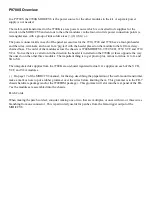
40
Chemical compatibility of wetted materials
AZURA® Conductivity Monitor CM 2.1S Instructions, V6710
(such as hydrofluoric acid, hydrobromic acid) and gaseous halogens.
Hydrochloric acid is approved for most applications.
In addition, following solvents can have a swelling effect and may have an
impact on the functionality of the built-in components: Methylene chlo-
ride, THF and DMSO in any concentration such as acetonitrile in higher
concentrations.
Polyethylene terephthalate (PET, outdated PETP)
PET is a thermoplastic and semi-crystalline material with high wear resis-
tance. It is resistant against diluted acids, aliphatic and aromatic hydrocar-
bons, oils, fats and alcohols, but not against halogenated hydrocarbons
and ketones. Since PET belongs chemically to esters, it is not compatible
with inorganic acids, hot water and alkalis. Maximum operating Tempera-
ture: up to 120 °C.
Polyimide (Vespel®)
This material is wear-resistant and permanent resilient thermically (up to
200 °C) as well as mechanically. It is chemically broadly inert (pH range
1-10) and is especially resistant against acidic to neutral and organic
solvents, but vulnerable to pH strong chemical or oxidizing environments:
It is incompatible with concentrated mineral acids (such as sulfuric acid),
glacial acetic acid, DMSO and THF. In addition, it will be disintegrated by
nucleophilic substances like ammonia (such as ammonium salts under
alkaline conditions) or acetate.
Ethylene-tetrafluorethylene copolymer (ETFC, Tefzel®)
This fluorinated polymer is highly resistant against neutral and alkaline
solvents. Some chlorinated chemicals in connection with this material
should be handled with care. Maximum operating Temperature is 80 ºC.
Perfluorethylenpropylen-Copolymer (FEP), Perfluoralkoxy-Polymer (PFA)
These fluorinated polymers hold similar features as PTFE, but with a lower
operation temperature (up to 205 °C). PTA is suitable for ultrapure appil-
cations, FEP can be used universally. They are resistant against almost all
organic and inorganic chemicals, except elemental fluorine under pres-
sure or at high temperatures and fluorine-halogen compounds.
Polyoxymethylene (POM, POM-HTF)
POM is a semi-crystalline, high-molecular thermoplastic material which
stands out due to its high stiffness, low friction value and thermic stability.
It can even substitute metal in many cases. POM-H-TF is a combination
of PTFE fibres and acetal resin and is softer and has better slip properties
as POM. The material is resistant against diluted acids (pH > 4) as well as
diluted lyes, aliphatic, aromatic and halogenated hydrocarbons, oils and
alcohols. It is not compatible with concentrated acids, hydrofluoric acid
and oxidizing agent. Maximum operating Temperature is 100 ºC.
Polyphenylene sulfide (PPS)
PPS is a soft polymer which is known for its high break resistance and very
high chemical compatibility. It can be used with most organic, pH neutral
to pH high, and aqueous solvents at room temperaturewithout concerns.
However, it is not recommended for using with chlorinated, oxidizing and





































